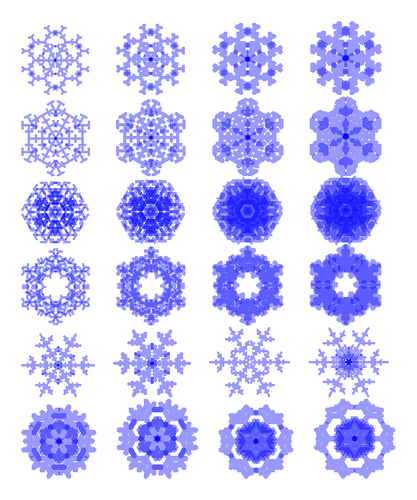One of the easiest approach for drawing snowflakes with TikZ is using Lindenmayer systems.
This code defines Lindenmayer rules for drawing a single "arm" of the snowflake. Symmetry should be crucial. Then this arm is repeated rotated 60 degrees each time to produce the complete snowflake.
By changing the Lindenmayer rules, the angle and the line width, you can get a lot of nice variations.
You may notice some scaling, this is just for getting similar dimensions, because we have different line widths.
This code was written by JLDiaz and published on TeX.SE.

Edit and compile if you like:
% Snowflakes with TikZ
% Author: JLDiaz
\documentclass{article}
\usepackage[textwidth=6cm]{geometry}% just for the preview
\usepackage{tikz}
\usepackage[active,tightpage]{preview}
\PreviewEnvironment{center}
\setlength\PreviewBorder{10pt}%
\usetikzlibrary{lindenmayersystems}
\pgfdeclarelindenmayersystem{A}{
\rule{F -> FF[+F][-F]}
}
\pgfdeclarelindenmayersystem{B}{
\rule{F -> ffF[++FF][--FF]}
}
\pgfdeclarelindenmayersystem{C}{
\symbol{G}{\pgflsystemdrawforward}
\rule{F -> F[+F][-F]FG[+F][-F]FG}
}
\pgfdeclarelindenmayersystem{D}{
\symbol{G}{\pgflsystemdrawforward}
\symbol{H}{\pgflsystemdrawforward}
\rule{F -> H[+HG][-HG]G}
\rule{G -> HF}
}
\tikzset{
type/.style={l-system={#1, axiom=F,order=3,step=4pt,angle=60},
blue, opacity=0.4, line width=.5mm, line cap=round
},
}
\newcommand\drawsnowflake[2][scale=0.2]{
\tikz[#1]
\foreach \a in {0,60,...,300} {
\draw[rotate=\a,#2] l-system;
};
}
\begin{document}
\begin{center}
\foreach \width in {.2,.4,...,.8}
{ \drawsnowflake[scale=0.3]{type=A, line width=\width mm} }
\foreach \width in {.2,.4,...,.8}
{ \drawsnowflake[scale=0.38]{type=A, l-system={angle=90}, line width=\width mm} }
\foreach \width in {.2,.4,...,.8}
{ \drawsnowflake[scale=0.3]{type=B, line width=\width mm} }
\foreach \width in {.2,.4,...,.8}
{ \drawsnowflake{type=B, l-system={angle=30}, line width=\width mm} }
\drawsnowflake[scale=0.24]{type=C, l-system={order=2}, line width=0.2mm}
\drawsnowflake[scale=0.25]{type=C, l-system={order=2}, line width=0.4mm}
\drawsnowflake[scale=0.25]{type=C, l-system={order=2,axiom=fF}, line width=0.2mm}
\drawsnowflake[scale=0.32]{type=C, l-system={order=2,axiom=---fff+++F}, line width=0.2mm}
\drawsnowflake[scale=0.38]{type=D, l-system={order=4,angle=60,axiom=GF}, line width=0.7mm}
\drawsnowflake[scale=0.38]{type=D, l-system={order=4,angle=60,axiom=GfF}, line width=0.7mm}
\drawsnowflake[scale=0.38]{type=D, l-system={order=4,angle=60,axiom=FG}, line width=0.7mm}
\drawsnowflake[scale=0.38]{type=D, l-system={order=4,angle=60,axiom=FfG}, line width=0.7mm}
\end{center}
\end{document}Click to download: snowflakes.tex • snowflakes.pdf
Open in Overleaf: snowflakes.tex


